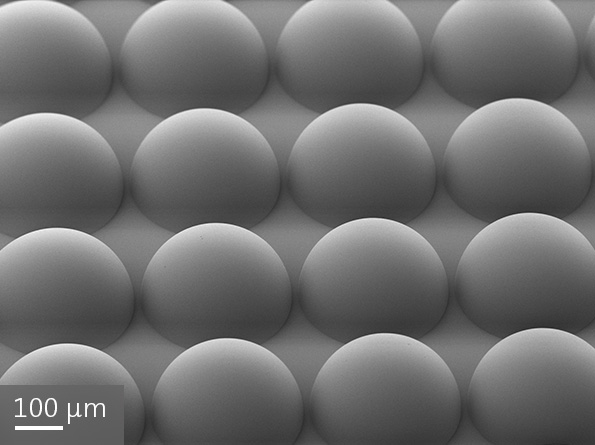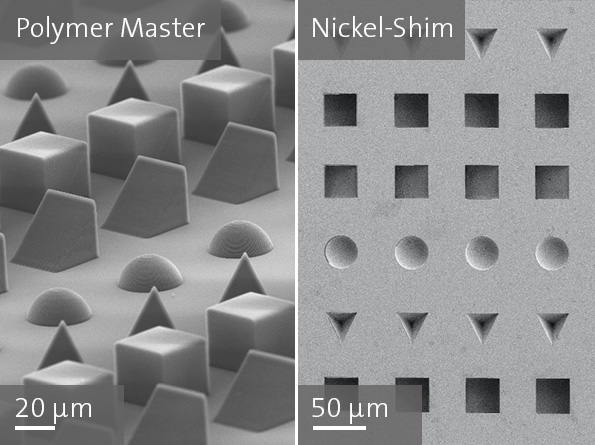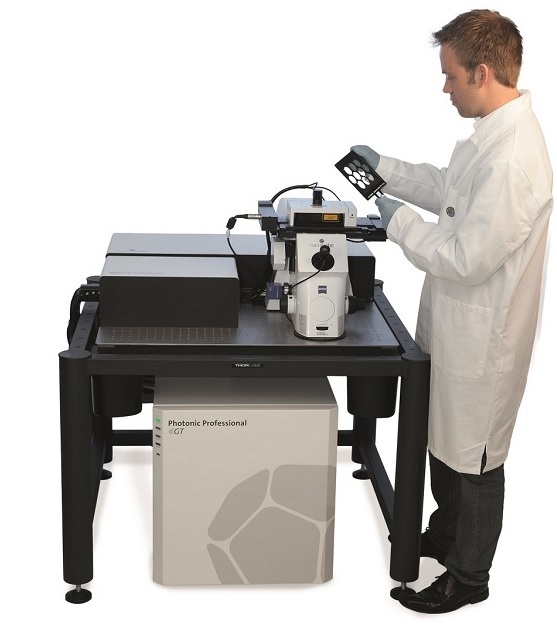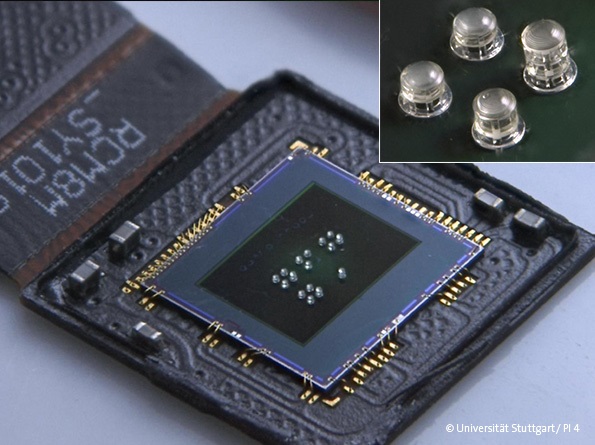June 19, 2017
Eggenstein-Leopoldshafen The German company Nanoscribe develops and produces high-precision 3D printing solutions enabling research and industry to innovate by additive manufacturing. Previously, the resolution and precision that is needed in the fabrication of micro-optical components was not provided by conventional additive manufacturing technologies. Using Nanoscribe's 3D printer Photonic Professional GT, which is based on the technique of two-photon-polymerization, a broad range of almost arbitrary micro-optical shapes including standard refractive micro-optics, freeform optics, diffractive optical elements or even multiplet lens systems can now be printed in a one-step process. Hence, Nanoscribe's 3D printing solution disrupts and breaks with previously complex workflows, overcomes long-standing design limitations and enables unprecedented applications driven by advanced micro-optics.
In combination with the right materials and processes, these 3D printers allow to directly fabricate polymer micro-optical components with significantly reduced geometrical constraints than standard fabrication methods, high shape accuracy and optically smooth surfaces. Its additive manufacturing workflow also drastically shortens the design-iteration phase and ideas can be turned into functional prototypes within just a few days. Polymer master structures for industrial mass replication, micro-optical components on waferlevel as well as complex compound lens systems and photonic wirebonds can be fabricated based on the same technology.
Examples of 3D printed micro-optics
Foveated Imaging
Researchers from the University of Stuttgart used a Photonic Professional GT system to print micro-objective lenses with different focal lengths onto a high-resolution CMOS chip. All images created by the lenses on the chip are simultaneously read out electronically and processed into an image with a significantly improved resolution in the center. This so-called “foveated imaging” is very attractive for the production of cameras with sensors that mirror the extra wide field of vision of an eagle's eye, e.g., for applications in the automotive or smartphone industry as well as in the medical field.

Array of hemisphere micro-optics fabricated with a Photonic Professional GT.
Array of micro-optic hemispheres
This array of hemispheres demonstrates the high shape accuracy and optically smooth surfaces achievable by using two-photon-polymerization. The printed hemispherical micro lenses have a shape accuracy better than 1 μm and a surface roughness better than 10 nm Ra. The array with a size of 1 square centimeter in total and hemispheres with a height of 150 μm was written into a solid negative tone resist. Due to the optimized combination of hardware and software components one can achieve a high and consistent precision on the whole area of the writing field.
Diffractive optical elements
Using a Nanoscribe system, the fabrication of diffractive optical elements (DOE) which typically have significantly smaller feature sizes than refractive optics, is possible as well. DOEs can be designed for functionalities that are hardly accessible with refractive optics, such as the generation of almost arbitrary light distributions in the far-field. By means of a Photonic Professional GT, functional multilayered diffractive optical elements can be directly patterned onto glass substrates enabling rapid protoyping and design iterations within a few days.

Nickel shim fabricated from a printed polymer structure by electroforming.
Nickel Shim
The challenge of fast and low-cost production of micro-optical elements can be solved by fabricating a nickel shim from the printed polymer structures by electroforming, allowing standard replication techniques such as injection molding or hot embossing to be used for subsequent mass replication. Replication using nanoimprinting is another viable route.
You will find further information in the application note "Micro-Optics" as well as in the folder "Photonic Professional GT".

Photonic Professional GT sets benchmarks in microfabrication
About Nanoscribe GmbH:
Nanoscribe GmbH, located in Eggenstein-Leopoldshafen near Karlsruhe (Germany), develops and provides 3D printers for the nano-, micro- and meso scale as well as photoresists and process solutions. Within just a few years, the company has managed to turn from a spin-off of the Karlsruhe Institute of Technology (KIT, Germany) to a medium-sized company and established itself as a global market- and technology leader for 3D printing on the nano-, micro- and mesoscale.
As of today, half of the top ten universities worldwide are Nanoscribe clients. A broad array of honors and awards, such as the 2014 Prism Award or 2015 WTN Award as well as Nanoscribe’s finalist position for the Deutscher Gründerpreis 2015 (2015 German Founders’ Award), underscore the extraordinary performance and significance of this expanding high-tech company.













